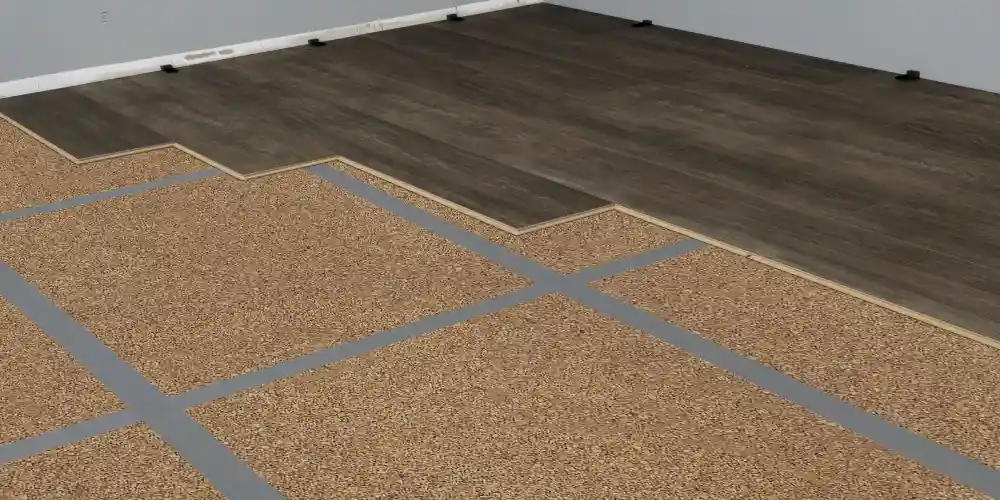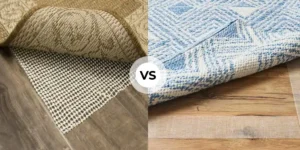Choosing the right underlayment for your floors might not be the most glamorous decision.
But it’s a crucial one. Cork and rubber underlayment take center stage in the battle to ensure longevity, comfort, and sound absorption.
Homeowners often find themselves pondering this question.
As they embark on the journey of renovating or installing new flooring.
So, why the debate? Let’s break it down in simple terms.
The answer lies in the diverse needs and preferences of homeowners.
Each material brings its own set of advantages to the table. And the challenge is figuring out which one aligns with your priorities.
Are you drawn to the eco-friendly allure and soft touch of cork? And seek a natural underfoot experience?
Or is the rugged resilience of rubber capable of enduring the wear and tear of daily life? Appeal to your practical side?
You Might Also Like:
- Cork vs. Foam Underlayment: Which is Right for Me?
- Can Mold Grow Under Vinyl Plank Flooring? (Answered)
Questions to Ask Yourself Before Choosing Cork or Rubber Underlayment
1. What type of room is it, and how will it be used?
When choosing between cork and rubber underlayment. Consider where and how it will be installed.
The following are some factors to consider.
- Room type: Underlayment requirements may differ by room type. A bedroom or living room may focus on comfort and soundproofing. While a kitchen or bathroom may focus on moisture resistance.
- Flooring type: Underlayment selection is also influenced by the flooring installed. A carpet, for example, may not need as much soundproofing as a laminate or hardwood floor.
- Traffic: How much foot traffic a room receives will affect underlayment durability. High-traffic areas, such as hallways and entryways, need a more durable underlayment.
- Comfort: When it comes to comfort, cork underlayment may be a better choice since it has more cushioning than rubber.
Consider these factors. Then, you can make an informed decision about whether rubber or cork underlayment is best for your specific needs.
2. What is the compression rate of the underlayment?
Underlayment should be chosen depending on how much compression will occur over time. Whether it is cork or rubber.
Check the material density before finalizing one. Since this can make it more likely to compress over time.
Compressibility is how easily a material can be compressed. And how much it will spring back into its original shape.
Some materials are not very compressible, and others are very compressible.
Moreover, the installation’s quality also contributes to your underlayment’s compressibility.
Depending on how well the underlayment is installed. It can affect the resistance of the underlayment to compression.
Proper installation can prevent underlayment compression, like gluing it down completely.
3. Which underlayment absorbs the most sound?
When choosing cork or rubber, consider which underlayment can absorb sound best. Here are a few things to consider:
- Material thickness: Underlayment thickness influences the underlayment’s sound absorption capacity. The thickness of rubber and cork underlayments varies. But a thicker underlayment absorbs more sound. The porous nature of cork makes it more effective at absorbing sound.
- STC Rating: Sound Transmission Class (STC) measures how much sound is transmitted through a material. A high STC rating is important when selecting underlayment. When installed correctly. Both cork and rubber underlayment can have high STC ratings.
4. What is the ease of installing underlayment?
Easy installation is a key consideration when choosing cork or rubber underlayment.
Underlayment can be installed by glue-down, nail-down, or floating methods. You may choose a method based on your flooring requirements.
Another factor that affects the ease of installation is the subfloor’s condition.
Before installing the underlayment. You may need to prepare your subfloor if it is uneven or in poor condition.
5. A Budget.
Budget is the most important factor when choosing an underlayment, but it is not the only one.
Cork and rubber underlayment are both more expensive than foam or felt underlayment.
Yet, they can be worthwhile investments. Thanks to unique features such as improved sound insulation and durability.
High-quality materials provide better sound insulation, durability, and longevity.
Cork Underlayment

Cork underlayment is a sublayer for hardwood, laminate, and vinyl floors.
Comes from the bark of cork oak trees, making it a natural and renewable resource.
Plus, it provides both comfort and protection for the flooring above.
As a natural insulator and noise reducer, it offers good sound absorption. And reduces impact noise and creates a quieter environment.
Which makes cork underlayment a great choice for homes and apartments.
It also has moisture-resistant properties. That not only prevents moisture but also saves the flooring from warping or swelling.
Furthermore, it provides a cushioning layer that enhances the flooring’s comfort and provides a cozy surface.
Generally, cork is more expensive than rubber. But it speaks for itself for the price it offers.
It is an eco-friendly, durable, and versatile sublayer for flooring that offers both protection and comfort.
Why use Cork for Underlayment?
Cork is popular as an underlayment material for several reasons:
- Its durability
- The ability to resist moisture
- An insulator
- Provides comfort
- An eco-friendly product
Pros
- Unlike other materials, cork is durable and resistant to breakages and damage.
- It prevents warping or swelling caused by moisture from warping or swelling above it.
- The cork’s natural insulation properties can regulate noise and temperature.
- A cork layer provides comfort and feels to the flooring above.
- Carpet, hardwood, laminate, and tile all work well with cork underlayment, making it a versatile option.
Cons
- It can be more expensive to use cork underlayment than other materials.
- Cork underlayment may be harder to find than other types of underlayment.
- Underlayments made of cork may require regular maintenance, such as sealing or refinishing.
Rubber Underlayment

Typically manufactured from synthetic or recycled rubber, it offers durability and resilience.
Valued for its durability and ability to withstand heavy foot traffic. Making it suitable for high-traffic areas.
As well as providing a strong and stable base for flooring. Rubber underlayment reduces noise levels.
Making it ideal for spaces where noise reduction is a priority.
Moreover, it can be eco-friendly if made from recycled materials. Otherwise, its production involves synthetic processes.
Also, rubber underlayment prevents the warping and swelling of the flooring above it. Due to moisture exposure.
Especially in areas where moisture is likely to accumulate. Such as basements and bathrooms, it is crucial.
Plus, it offers moderate thermal insulation properties, contributing to energy efficiency.
Besides being affordable, it is often one of the most desirable options for budget-conscious consumers.
Why use Rubber for Underlayment?
Underlayment made from rubber has several benefits, including:
- Efficacy and durability
- The ability to resist moisture
- The ability to absorb sound
- Maintaining stability
- Inexpensive installation
- Cost-effectiveness
Pros
- Rubber is strong and durable and can withstand heavy foot traffic.
- Rubber’s sound insulation properties reduce noise levels.
- Rubber underlayment reduces movement and prevents damage to flooring.
- Easy installation makes rubber underlayment a convenient option for quick flooring projects.
Cons
- Due to off-gassing, rubber underlayment emits solid odors and can harm pets.
- Rubber underlayment can trap moisture and lead to mold growth. When not correctly installed and maintained.
- Heat is retained by rubber underlayment, making it unsuitable for exposed areas.
- Rubber underlayment may cause allergic reactions in some people.
What Are the Differences Between Cork and Rubber Underlayment?
Rubber and cork are popular materials used as underlayments for flooring.
But they differ in a few important ways that can impact their suitability.
Here are some major differences between cork and rubber underlayment:
- Material: Some rubber underlayment is made from recycled rubber. This makes it an eco-friendly product. Cork underlayment is made from the bark of oak trees. This makes it naturally eco-friendly.
- Thickness: Cork underlayment typically measures around 6 mm, thinner than rubber underlayment. Rubber underlayment is usually thicker, with a maximum thickness of 12mm.
- Soundproofing: Rubber and cork underlayment can provide good soundproofing for floors. But rubber tends to be more effective at absorbing impact noise. While cork is better at absorbing airborne noise.
- Moisture resistance: Cork underlayment is naturally moisture resistant. But they can be damaged by prolonged exposure Underlayments made of rubber are more resistant to water damage. And are better suited to humid environments.
- Installation: Underlayments made of cork are easy to install. And usually available in interlocking panels or rolls. Whereas, rubber underlayment is heavier. And may need adhesive to hold, so it is generally more difficult to install.
To Conclude
In the cork vs. rubber underlayment debate. Your choice boils down to your priorities.
If you focus on a soft and eco-friendly option, cork might be the way to go.
But, if durability and resilience are your main concerns, Rubber underlayment might be a better fit.
Understanding these basic differences can help you make an informed decision. That aligns with your specific flooring needs.
FAQs: Cork vs. Rubber Underlayment
Is cork underlayment more eco-friendly than rubber?
Cork underlayment is generally more eco-friendly than rubber underlayment.
Because it is produced sustainably, uses renewable resources, and is biodegradable.
Conversely, rubber is petroleum-based and can take a long time to decompose, so it is not considered as eco-friendly as cork.
Is rubber underlayment more moisture-resistant than cork?
Yes, rubber underlayment has higher moisture resistance than cork underlayment.
Rubber is naturally water-resistant and does not absorb moisture as readily as cork, which can expand and deteriorate when exposed to moisture.
What are the benefits of using cork underlayment compared to rubber?
There are several benefits to using cork underlayment compared to rubber underlayment:
1. Sustainable material
2. Excellent sound insulation
3. Thermal insulation
4. Compressive strength
5. Moisture resistance
6. Eco-friendly
Overall, cork underlayment offers excellent sound insulation, thermal insulation, and compressive strength while being a sustainable and eco-friendly choice.
Check Out More Articles Related to Flooring
- Cork vs. Foam Underlayment: Which is Right for Me?
- 7 Best Flooring Knee Pads for Floor Installers and Homeowners
- How to Move Your Fridge without Scratching the Floor? (Tried & Tested)
- Do You Put Vinyl Flooring Under Appliances? (Answered & Explained)
- 5 Best Ways to Protect Vinyl Flooring From Heavy Furniture (Must-Try!)





